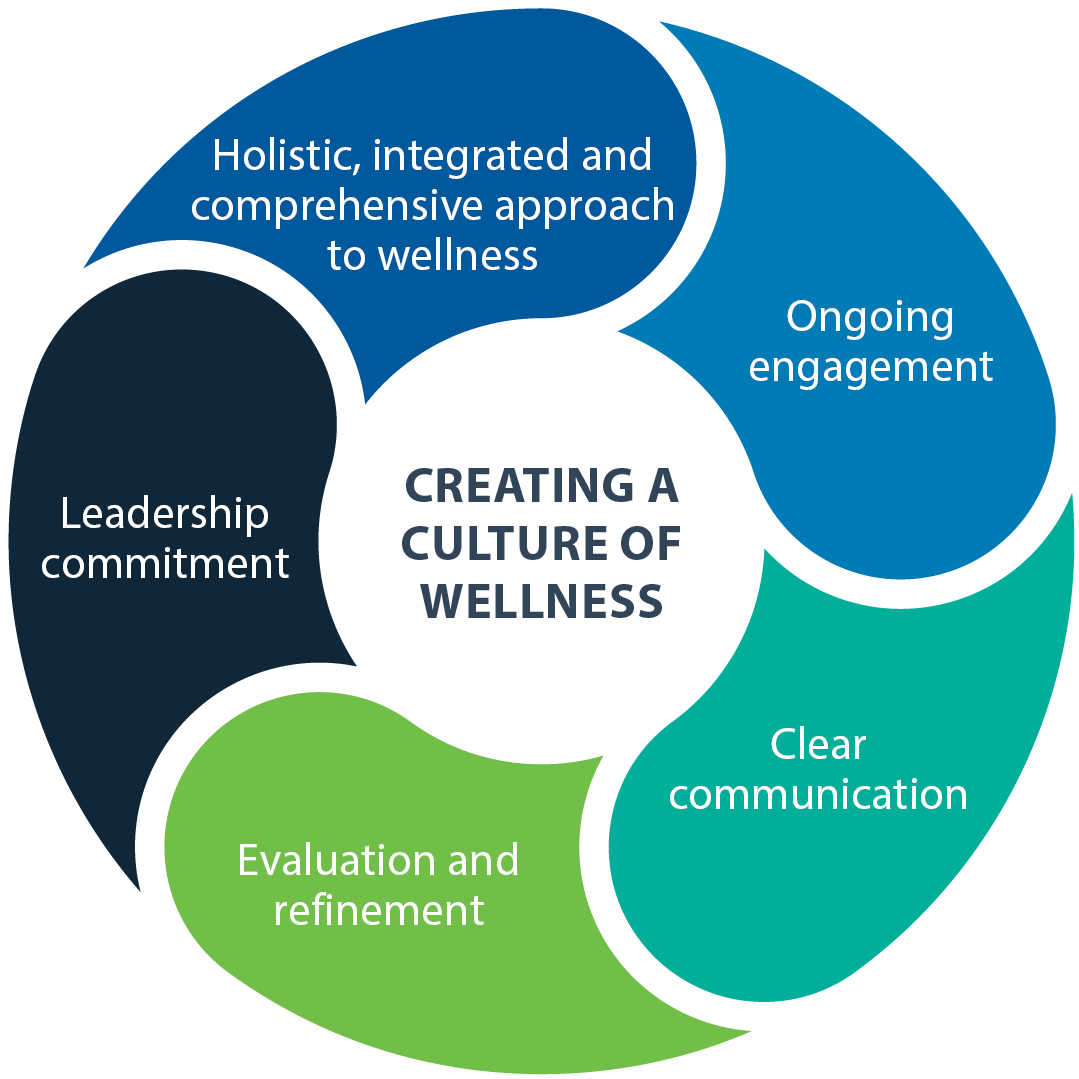
Workplace wellness framework
Healthy employees create healthy organizations. Workplace wellness happens when workplaces focus on and prioritize the creation of a healthy culture. Our workplace wellness framework can help you take the next step in your organization’s wellness journey.
Healthy employees create healthy organizations. Workplace wellness happens when workplaces focus on and prioritize the creation of a healthy culture. Our workplace wellness framework can help you take the next step in your organization’s wellness journey.
What is workplace wellness?
Sometimes it seems like everyone has a different answer when it comes to defining wellness—and it feels like there is no simple answer. Wellness involves many aspects of an individual’s or organization’s well-being including financial stability, social engagement and physical and mental health. Workplace wellness involves a comprehensive and human-centered approach to supporting these major aspects.
We believe with the right tools, approach and commitment, your journey towards cultivating a healthy workplace culture can become more tangible. Let us help you on your organizational wellness journey.
Current state of mental health in the workplace1

24%
or nearly one quarter of Canadians have considered leaving their current job due to their employer’s response to COVID-19

At 53%
increased mental stress and strain at work is the most reported reason employees consider leaving their job

Over 1/3
of Canadians report being concerned about a co-worker’s mental health

73%
of Canadians indicated that the COVID-19 pandemic has had a negative impact on their mental health
Developing a healthy workplace takes discipline, commitment and care
No matter where you start, the goal is continuous improvement. Alberta Blue Cross® can provide support and insight to make it easier for your organization to take the next step, however big or small, in building a healthy workplace culture.
Culture and engagement have become clear priorities in recent years as organizations compete to recruit and retain top talent. Healthy organizations have employees who feel safe, valued and inspired. And engaged and thriving employees gives your organization a more competitive business advantage.
How can I create a culture of wellness?
Alberta Blue Cross® is dedicated to supporting organizations committed to achieving workplace excellence. We understand that not all wellness approaches or treatment models work—this is why we do things differently.
We recently commissioned a study to explore the factors that promote and inhibit the uptake and implementation of wellness programs within organizations.
From the study findings we developed a white paper, which you can use to begin your organization’s wellness journey. You can find the full paper here and you can also check out our blog for a quick recap on the steps and considerations that are fundamental to building a successful wellness plan.
The Alberta Blue Cross® approach
Most adults spend more waking hours at work than anywhere else. This makes workplaces a significant contributor to one’s overall sense of health and well-being. Workplaces play a big role in helping employees live their best life; however, workplaces can also be a contributor to various stressors. Over time, these stressors can have a negative impact on a person’s optimal state of health—this includes their psychological health.
We also understand that not many wellness approaches or treatment models on their own have been successful. Tip: Shift your thinking from treatment to wellness to become less reactionary and more empowered.
Our five guiding principles were established as a starting point to gain traction, inform strategic direction and champion what it takes to cultivate healthy cultures.

Breaking down our approach to wellness
If you’re ready to start implementing wellness in your organization or you want to take your existing wellness program to the next level, here are some practical steps to follow and tools we provide for support.
To see these steps in action, check out our 15-minute wellness breaks case study.
Leadership commitment
Success comes from supporting and inspiring leadership within organizations to lead by example, embed a strategic approach to wellness, take preventative measures, promote wellness and create programs and activities. Leadership commitment covers the overall operations and corporate culture.
- Graham Lowe - High-trust Workplaces Promote Employee Well-being
- Graham Lowe - Resilience and Beyond
- Secure leadership support and endorsement
- Establish a committee to drive a strategic vision
- Mental health training for senior leaders—the Working Mind, CMHA
- Foster a culture that promotes wellness, check out ABC values
Holistic, integrated and comprehensive approach to wellness
Assess current workplace health activities and organizational policies and practices to discover wins and existing gaps.
- Analyze employee wellness surveys
- Review trends and key metrics
- Guarding Minds survey - Assess and address psychological health and safety in your workplace
- National Standard for Psychological Health and Safety in the Workplace (the Standard)
- Review Occupational Health and Safety legislation
- Build an action plan of key priorities and themes
- Healthy workplace quick assessment
Ongoing engagement
Engagement comes from empowering leaders at every level to emerge with creativity and new ideas to support and promote a healthy culture. Organizations that care for their employees often create positive working conditions, attract talent, have higher retention and experience higher engagement.
Here are a few engagement examples that we successfully implemented for our employees.
- Policies and procedures
- Guidelines
- Determine resource needs
- Change management considerations
- Employee engagement and ongoing feedback and touchpoints
- Pulse checks
- Town halls
- Wellness champions initiative
- Gratitude challenge
Clear communication
Success requires a commitment to support clear and concise messaging to ensure your audience can understand your message—be sure to meet them where they’re at and consider their stage of readiness to act.
- Explore communications methods and channels
- A Practical Toolkit to Help Employers Build an Inclusive Workforce
- Mental Health - Having Courageous Conversations
- Workplace Mental Health toolkits (AHS)
- Wellness through Balance® - Alberta Blue Cross®
- Wellness through Balance® - Employee brochure
- Workplace Wellness Resources
- Building your emotional resiliency
Evaluation and refinement
Once your program or initiative is launched, don’t stop there. Evaluate your successes and learnings to determine best practices to help validate outcomes, speak to various stakeholders and remain competitive in your industry. This includes measuring the effectiveness of wellness solutions, programs and services. Well-designed and effectively implemented workplace wellness programs can reduce absenteeism, presenteeism, turnover, health benefits costs and disability rates. This results in the opportunity to improve your return on investment over time and help you understand how your efforts impact the bottom line.
- Review benefits claims reports for data
- Budget and resource allocation
- Evaluate communications strategies
- Audits
- Healthy workplace quick assessment
- Human Resources metrics
- Indexes and scorecards
Assess the wellness of your workplace today
How do you foster a culture of wellness in your workplace?
Let’s help you find out! Once you complete this assessment, we’ll provide some answers and tips for where you can start making changes to build a healthier workplace.
Public tools and resources to support you
We heard you. In our pre-event survey, many of you requested resources surrounding some common themes. We’ve compiled a list of resources below to support you.
Resources
Loneliness and social isolation
The feelings of loneliness and isolation among employees have heightened due to social distancing measures and remote work protocols over the past year. This has taken a toll on employees’ mental health and well-being.
We have compiled a number of resources to help individuals and organizations understand what they can do to help reduce the feelings of loneliness due to social isolation and improve their health.
Graham Lowe’s - resolving the pandemic paradox of flexible work Employee Fatigue, Isolation, and Loneliness Social Isolation and Loneliness Vital signs annual check-upReducing stigma
Now more than ever, it is imperative to reduce the stigma of mental health in our workplaces. Humans are complicated and complex, and it is difficult for someone to address their needs and seek support from their co-workers or managers if they feel they will be judged or negatively affected. By working to eliminate negative perceptions of those struggling with mental health or anxiety, we can position ourselves to be more compassionate and empathetic. We have a collection of resources to help understand how to reduce stigma.
CMHA Mental Illnesses in the workplace The Invisible Wounds of Mental Health Disorders How can I help someone in mental distress Reducing Mental Health Stigma Beyond StigmaSuicide prevention
The death of a colleague by suicide leaves a heavy emotional and financial burden on family, friends, co-workers and their place of work. Suicide touches everyone; and with employees spending more than half of their time at their place of work, it also directly impacts their workplace. Education on how to prevent, address and approach suicide in the workplace is becoming more important, especially as the pandemic continues.
Mental health support The workplace and suicide prevention CMHA Alberta Crisis Guide CMHA Alberta Resource GuideWorkplace specific resources
We have collected additional resources specific to the workplace, including materials about building self-care and resiliency for mental health. Over time, we will add more specific topics that are impacting workplaces, such as alcohol and drug use.
Graham Lowe’s - Healthy organization guiding principles BestLifeRewarded Innovations Canadian Centre for Occupational Health and Safety Creating a Healthy Workplace MHCC Toolkit 1 - Implementing the standard, introduction MHCC Toolkit 2 -Implementing the standard, takeaways MHCC Toolkit 3- Implementing the standard, lessons from the 40 MHCC Toolkit 4- Implementing the standard, checklist MHCC Toolkit 5 - Implementing the standard, taking action MHCC Toolkit 6 - Quick reference, resources guide Mental Health Toolkit Mental Health Case StudyTools
We have collected additional resources and tools that you may find value incorporating into your workplace wellness programs. These resources will assist as a supplement of a larger wellness program or initiative and not as a stand-alone action.
Graham Lowe’s - change readiness checklist Graham Lowe’s - action checklist Lifestyle management Chronic disease management Diabetes Heart disease Connecting to health care The Working Mind Self-care & Resilience Guide Emotional triggers tool Multicultural Competency Self-Reflection Worksheet Self talk Renovation Six dimensions focus toolWhite papers and case studies
Wondering how to make a wellness plan?
Some employee wellness programs are more successful than others. This white paper highlights four key factors for success when implementing wellness programs and how they can support your organization.
Mental health in the workplace
According to the World Health Organization, around 450 million people currently struggle with mental illness making it the leading cause of disability worldwide.
Five steps to build an effective wellness initiative
In 2018, we launched our daily 15-minute wellness breaks initiative for our team members. This case study breaks our process down into five, easy-to-follow steps to help guide your organization’s wellness journey.
Was this information helpful?
Thank you for your feedback

How to seek (and keep) mental health goals
Goal setting is a hot topic in the business world. A quick Internet search will give you a plethora of advice on how to set and achieve your goals, from making them...

Text4Hope to support your mental health
From social distancing to self-isolation, the lives of Albertans look a lot different right now. As we navigate through the COVID-19 pandemic, fears and concerns...

Let’s talk about mental illness
Mental illness is more common than you think—it affects about 9.1 million, or one in three, Canadians during their lifetime. It doesn’t discriminate and can affect anyone...
All information, content, and material contained on this web site (including links to other third-party web sites) is provided for general information purposes only and does not constitute medical or other professional advice on any subject matter, or for any individual case or situation. Nothing on this web site is intended to substitute for the advice of a qualified medical professional, and you should not act, or refrain from acting, on the basis of any content included on this web site. If you require medical advice, you are advised to consult a qualified medical professional.